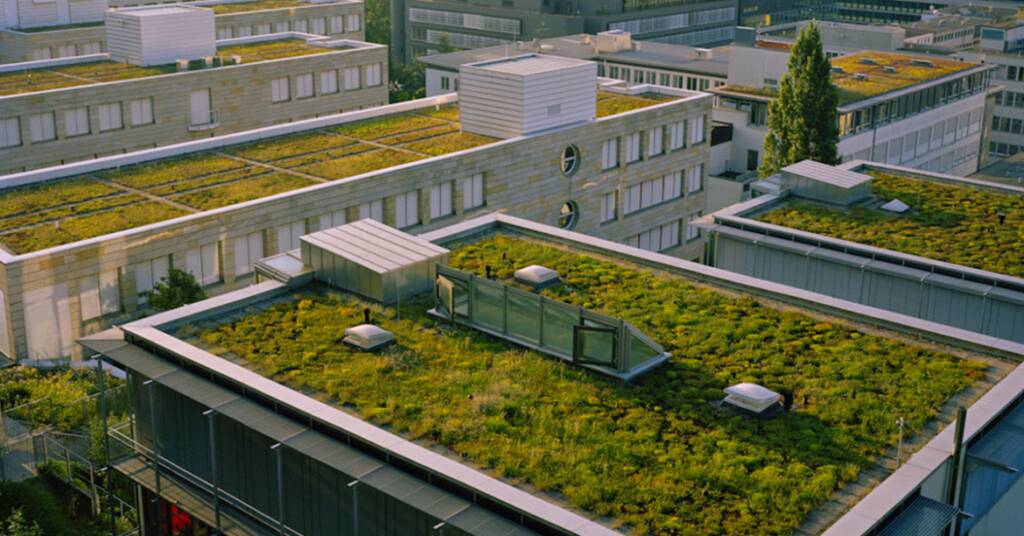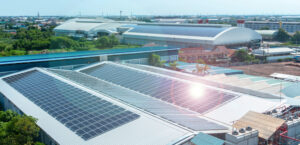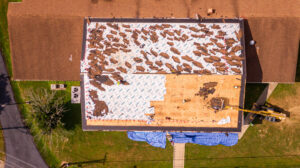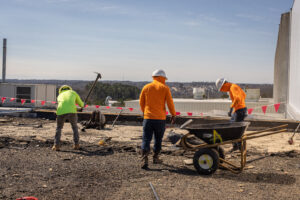
Many roofing companies have been turning to a new era of roofs. These roofs allow for a coefficient of performance that is unheard of in commercial roofing. While the installation cost may be higher, the returns for these types of roofs are quickly realized through lower energy costs and improved environmental impacts.
When it comes to commercial roofing, integrations of advanced technology are expected to pave the way for future generations of rooftops. Among the various trends that are expected to grow in 2024, several have been identified by leading industry professionals, reflecting a dynamic market projected to grow at a CAGR of around 6.6% from 2024 to 2032, potentially reaching around $41.50 billion by 2032. These are summarized below:
Metal Roofing: The Biggest Trend For 2024
Metal roofing is quickly becoming the industry standard. Metal roofing systems are showing growth in commercial sales, with architectural standing seam projects accounting for a significant portion of commercial sales. Metal roofing is valued for its durability and energy efficiency. These roofs allow for maximum energy efficiency and, at the same time, excellent thermal retention that helps to reduce cooling costs in the summer months. In addition, metal roofs can be made to appear as though they are traditional asphalt shingles or clay tiles. This allows them to blend seamlessly with other traditional roofing systems, giving them a fresh appeal.
Green Roofing
Green roofing is becoming an increasingly popular option for commercial properties. This allows for a high degree of insulation, which helps to further reduce energy costs associated with cooling. In addition, green roofs help to improve indoor air quality by filtering the air that is circulated throughout the building before it exits through rooftop vents. With many studies pointing toward the benefits of green roofs, commercial roofing companies can expect an increasing demand for these types of roofs in 2024.
Solar Integration Into Roofs
While solar panel technology allows for energy generation, it can also be integrated into the roof itself to reduce costs associated with installation and associated regulatory planning. This has allowed companies to focus their attention on an aesthetically pleasing design that helps to reduce costs associated with heating and cooling.
As renewable energies become more common, it is expected that energy storage efforts will need to grow in order to support the integration of sustainable technologies on a wider scale. When looking at the future of commercial roofs, there is a strong push for energy storage capabilities with an emphasis on battery storage technology. This has left companies scrambling to develop batteries with better storage density and more affordable costs. Just like the advances we have seen in solar integration, this technology can also be integrated into metal roofs to further lower costs and improve aesthetics. Metal roofs with solar inclusions can be designed to look like traditional roofing materials – allowing them to blend in more seamlessly.
Cold Roofing
This type of roofing system is designed to help reduce cooling costs by up to 30 percent. Unlike traditional roofs, cold roofs are made with materials that have a thermal resistance index that is much higher than traditionally used in commercial roofing. This allows for heat to be retained more easily, which helps to prevent heat loss through the rooftop during hot periods. When roofs have a high thermal resistance index, it is easier to reduce the demand for air conditioning during the summer months.
As companies look towards a future that promises lower costs and heightened environmental awareness, monitoring energy performance will become an integral part of commercial roofs. Cold Roofs, in particular, have been shown to save considerably on heating costs by providing a thermal resistance index that is two to three times higher than the competition. When looking ahead, this is expected to be a major trend for 2024 and beyond.
Colorful Roofs
As commercial roofing companies strive to create roofs that stand out from the crowd, more attention is being paid to colorful roofing options. This is because of the potential for a company to make its business name or logo visible from far away, helping to attract more customers. In addition, colorful and aesthetically pleasing roofs can help improve the overall look of the building, making it more attractive to those passing by.
In 2024, we expect to see an increasing trend toward colorful roofs in commercial properties. With new technologies such as metal coatings and ceramic tiles allowing for greater customization, there are now limitless possibilities when it comes to colors and designs. Commercial Companies can also use this opportunity to create a unique identity for their business, which can be invaluable in helping to attract customers. By combining energy-saving principles with innovative design features, colorful roofs are sure to be a hit in 2024 and beyond.
Synthetic Roofs
With many buildings and property owners switching over to metal roofs, synthetic roofing companies are looking for ways to stay relevant. As a result, there has been an upsurge in research into new materials that have the same low-maintenance benefits as traditional waterproof membranes but are also lightweight, durable, fireproof, and impact resistant.
Synthetic roofs are made with materials like plastic and rubber. These roofs reduce the long-term costs of running a building through easy installation and durable materials. The best aspect of these roofs is that they can be customized to meet your specific requirements, making them excellent for commercial structures such as stores and warehouses. They are recyclable and have a lesser impact on the environment.
Smart Roofing Systems and IoT Technology
The integration of Internet of Things (IoT) technology in commercial roofing is a major advancement. These smart systems involve embedding sensors in the roof to monitor various conditions like temperature, moisture levels, and structural integrity in real-time. This technology aids in proactive maintenance and timely repairs, thereby enhancing the roof’s lifespan and performance. It contributes to energy efficiency and cost reduction by providing valuable data for optimizing building operations.
Advanced Roofing Materials
Innovations in roofing materials are centered around improving durability and weather resistance. This includes the development of composite materials, like reinforced polymers and advanced metal alloys, which offer increased strength and longevity. The use of eco-friendly materials, such as recycled rubber and metal, also contributes to sustainability. These advancements are crucial in addressing the challenges posed by extreme weather conditions.
Self-Healing Materials
Research into self-healing materials for roofing applications is a promising area. These materials can automatically repair minor cracks and damages, thus reducing maintenance needs and extending the roof’s lifespan. Self-healing technologies typically involve encapsulated liquids or microcapsules that release healing agents upon damage.
Drone Technology
Drones are increasingly being used for roof inspections, offering a safe, efficient, and comprehensive way to assess roof conditions. Equipped with high-resolution cameras and thermal imaging, drones can detect leaks, insulation problems, and other issues without the need for physical roof access. This technology saves time and minimizes the risks associated with manual inspections.
Emerging Technologies in Roofing and Waterproofing
The industry is exploring the use of adaptive and responsive materials, solar roofing, 3D printing for roofing components, moisture-activated adhesives, phase-changing materials, and nanotechnology in water-resistant coatings. These innovations are expected to redefine energy-efficient roofing and enhance building resilience.
Future of Commercial Roofing in 2024
As commercial roofing continues to evolve, research has revealed a number of trends to keep an eye on. With a rise in the adoption of green solutions, businesses and industrial facilities will be looking to integrate technologies like better battery storage and cold roofs, which allow for a high degree of insulation. A rise in synthetic roofing materials is also on the horizon as companies look to reduce their environmental impact. With these new trends expected to be major players in 2024, businesses should set themselves up now by choosing commercial roofing contractors that are advanced and knowledgeable about the trends. They will need to stay current on the latest advancements in technology and ensure they are prepared for what’s ahead.






